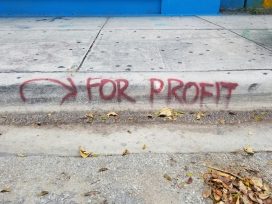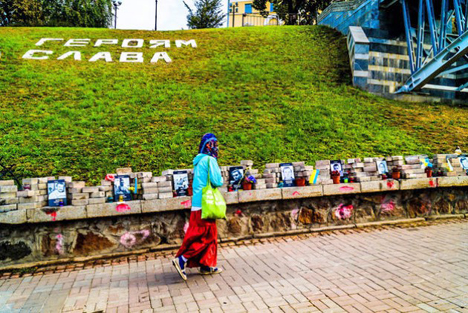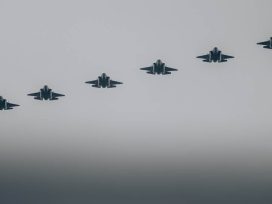
As capital consolidates, culture recedes, funding vanishes, access narrows. The question persists: why fund culture at all? Cultural managers from Austria, Hungary and Serbia discuss.
The far Right continues to capitalize on the extremes of the conflict in eastern Ukraine and the country’s deepening economic crisis, writes Kostas Zafeiropoulos, even as key elements at this end of the political spectrum regroup.
Two years have passed since the dramatic events of February 2014. In the centre of Kyiv, life seems to be rumbling along normally.
On the streets around Independence Square, carefree tourists and young Ukrainians take selfies in front of the statue of liberty under the gaze of passing Ukrainians dressed in either the national colours of blue and yellow or military fatigues.

Maidan Square, Kyiv. Photographs in memory of the hundreds who died in the blood-stained February of 2014. Photo: Kostas Zafeiropoulos
Some are veterans of the ongoing conflict in the east of the country, others volunteers, self-proclaimed patriots, and some just passers-by. On Institutskaya Avenue, where in 2014 snipers fired on the crowd from neighbouring buildings and hotels, passers-by are stopped in their tracks daily by hundreds of photographs swathed in flowers of their dead compatriots.
We are travelling in a divided Ukraine, searching for answers in the conflicting narratives about the social, economic and political situation of a country in which one of the most dangerous international crises since the end of the Cold War has developed.
Multinationals’ imposing billboards crop up in the endless expanses of the old Soviet Union granaries.
One of them displays Bayer, but these aren’t adverts, rather the markers of areas that belong to this particular colossus.
On the outskirts of Kyiv there are the huge Soviet tower blocks, 30-storey clusters, the “blind sides” of which are covered in multi-coloured graffiti.
The city centre is dominated by the third largest river in Europe, the Dnipro.
The Dnipro in Ukrainian, or the Dnieper in Russian, seems like a geographical boundary which reminds us that historically the now bilingual Ukraine, formerly the USSR’s centre of heavy industry in the east of the country, was always a crossroads of rivalry, first between Russia and Poland-Lithuania, and then the Ottomans and the Austro-Hungarian Empire.
The lengthy armed struggles of the nineteenth century in the wider region, the Crimean war (1853-56), the continued antagonism of the great powers, the domestic policy of tsarist Russia in Ukraine with the prohibition on the use of the Ukrainian language against the backdrop of a process of aggressive Russification are limited only by historical events which define – in part – elements of today’s situation too, in what is called “the attempt to repress Ukrainian identity”.
The incalculable catastrophe that befell Ukraine during World War I, the 1917 famine, the bloody post-war expulsions of Poles in return for Ukrainians, but also the recognition by the Soviets of the freedom of the Ukrainian Republic, emboldened the revival of Ukrainian sentiment.
On the other hand, the consequences of forced collectivisation affected Ukraine disproportionately more than many other areas of the USSR, something that has been transmitted into the collective unconscious of current generations.
However, World War II caused more than double the losses in the population compared with coterminous countries and of course the systematic extermination of many of Ukraine’s Jews by the Nazis.
After 1989, Ukraine was afflicted for years by recession, stagflation and political indifference.
It got its own currency due to hyperinflation, while public property was privatized, passing into the hands of the rising oligarchy.
A country with an ailing national identity was for years the contestable trophy between the West and Russia.
The global economic crisis of 2008 inevitably affected Ukraine’s weakened economy, which faced the dilemma of trading links with Europe (equating to “structural reforms”) or more and greater dependence on Putin’s Russia for cheap gas and low interest loans.
All this culminates in the events of February 2014, with the demonstrations that spilt blood, the routing of the elected president Yanukovych, Russia’s annexation of Crimea and the start of hostilities in the east of the country, in Donbas.
And even if the “Minsk II” truce agreement is ostensibly holding up, in reality the war is going on, militarily and diplomatically.
More than 10,000 people have already lost their lives, thousands are displaced and all the while the economic crisis is deepening in a divided country where the oligarchs remain centre stage.
“In Ukraine the political and business elite are not interwoven, as seen in Greece, they are one and the same. Many judges have five Porsches each and million-dollar villas. The same goes for many parliamentarians, whose official salary is 300 euros”, a western diplomat explains to us.
We are outside the Ukrainian Parliament where some of the most expensive limousines with blacked-out windows keep going past.
The president of the country is billionaire Petro Poroshenko, “the chocolate king”, so named due to his business success.
Poroshenko’s chocolate factory was previously named the “Karl Marx Chocolate Factory”.
Saturday afternoon, near Vystavkovyi metro station, in a big park, in the outskirts of Kyiv.
It is the festival of volunteers, as it is known, an event dedicated to soldiers returning from the Donbas front and their families.
They are called ATO soldiers (antiterrorists), something akin to an antiterrorist army.
For the majority of western Ukrainians, the words “terrorist”, “Russophile” and “separatist” signify anyone fighting on the other side in eastern Ukraine.
Dozens of volunteers, psychologists, professional doctors and lawyers as well as some NGOs are at the event, to help people returning from the front with physical and psychological injuries.
Women are singing traditional Ukrainian songs from the pro-communist period, while small children play with soldiers showing them their weapons.
“I lost many friends and it’s hard to adjust to civilian life. I will never forgive them (the separatists in Donbas) for the foot I lost and the dead children I saw”, says war-wounded Dimitrov, adorned with medals.
Beside him, Yuri, an army officer for 16 years, also lost his foot in the war.
“We have many historical problems in Donbas from the time the communists took farmers’ land and villages went hungry”, says Yuri, who fought at the front for 11 months.
Both reject the notion that it’s a civil war, but rather a “Russian invasion”, and they are optimistic they will manage to take back Crimea and Donbas.
“All the separatists have Russian flags, use Russian weapons, tanks, heavy artillery, drones, they’re brand new weapons, not from the Soviet times”, says Yuri, stating that he fought alongside volunteers from Belarus, Georgia, Poland, Azerbaijan and some from the USA and Canada.
“For us, the Right Sector and the Azov Brigade are our brothers, patriots”, say Yuri and Dimitrov, maintaining that there were dozens of Ukrainians of Greek origin in the (fascist) Azov Battalion.
Amongst the children, the soldiers, the wounded and their families, there are several members of the notorious Right Sector.
We met Andre Tarasenko, current leader of the far right party, which failed to get into Parliament in the recent elections.
His shirt, which says “No Knives No Lives”, is covered in knives, forming an unmistakable swastika.
Just before we photograph him he carefully zips up his jacket.
“We are not fascists, we’re not racists; we are nationalists. Yes, we’re an extreme party, but we don’t hit people for no reason”, he says, describing his organization as “the radical party of the Maidan demonstrators. We didn’t have weapons the whole time, only in the final days of the demonstrations some people might have had them”, he admits.
“We set up Right Sector because we wanted to show our nationalist outlook. Then the students were beaten up by the police and in a way it was self-defence that happened. The aim was to overthrow the Yanukovych regime and we did it. We wanted to change the system, but we still haven’t achieved that yet”, says Tarasenko.
Asked about their links with the Greek far Right he replies, “We had some contact with Golden Dawn in the past but we cut it because they are with Putin who funds most far right European parties, like Le Pen.”
“The war wounded return as national heroes. If in due course it is shown that they have far right ideas, there’s a great internal struggle in everyone, ‘yes but they fought for Ukraine, they fought for me, they were the vanguard’, many people think. It is a massive threat to Ukraine and to democracy. At least the Ukrainian language news media are now a bit more inclusive of different voices, there is a public debate which wasn’t there under Yanukovych, we hear stories of terrible crimes committed by Ukrainians”, says Maxim Butkevych, former journalist and now activist in the organization NoBorders for refugee and migrant rights.
He is wearing a shirt showing the names of two of his imprisoned countrymen, two Ukrainian anarchists as he tells us, who were arrested in Crimea.
They are now in solitary confinement in prisons in Russia and a wave of protest calling for their liberation is developing in Kyiv.
“I knew people who supported the war, went to the border and have open relationships with the Far Right. The war gives them a raison d’être, it gives them the possibility of political influence. The general feeling is ‘we are resisting a conquering power, a foreign force'”, Maxim explains, adding that “as long as the war goes on it is impossible to express the increased social malaise. Society is completely polarized, but not between pro-Ukrainians and Russophiles, but between nationalists and liberals, i.e. socialists, some conservative, some left wing, some anarchist, basically anyone who thinks human rights come first.”
“It is not a question of increased risk against minorities; the fascists are not attacking black people, refugees and Jews here”, explains sociology professor at Kyiv University, Volondimir Isenko, saying that “the point is that members of the far Right are taking over institutional jobs, like the Kyiv chief of police who is openly connected to the Azov Battalion”.
Right Sector is not the critical problem it was two years ago, now the real danger is the Azov battalions: neo-Nazis, armed, attempting to unite assorted war veterans together with young fascists, hooligans and skinheads” [sic], says Isenko, recalling the close ties of the current Minister of Interior with the far right.
“There is still a ferocious propaganda war from both sides. In 2014 the police gave us a savage beating. The thousands of people, workers, students, pensioners who held out in minus 15 degrees in the freezing cold in the squares, found one vision, they started to feel that they weren’t just living in Kyiv but in one country. We wanted to change the reality we were living in. We were looking for a just society where the police didn’t hit you, the boss didn’t swear at you and judges weren’t so corrupt”, explains professor of Greek language and director of Greek Studies Andrei Savenko, who is now concerned about far Right extremism but who has no confidence whatsoever in the new president.
“Clearly the Far Right played an important role in Euromaidan. From what I saw I did not realise that protestors or police were being shot by nationalists or far right extremists. Until the moment we learned it officially only one person came out publically and stated that he shot protesters”, says Maxim Butkevych.
The overwhelming majority (but not all) of those we meet in Kyiv and who experienced the events of 2014 up close have exactly the same story.
For them it was above all “a revolution of dignity against a corrupt regime and subsequently a social reaction against forcible police repression”.
The irony of the story is that the word Ukraine is etymologically based on the Slavic word “kraj”, which means “edge” or “border”.
Published 26 December 2016
Original in Greek
Translated by
Lucy Miles
First published by efsyn.gr, 28 October 2016 (Greek version); Eurozine (English version)
Contributed by Kostas Zafeiropoulos © Kostas Zafeiropoulos / efsyn.gr / Eurozine
PDF/PRINTSubscribe to know what’s worth thinking about.

As capital consolidates, culture recedes, funding vanishes, access narrows. The question persists: why fund culture at all? Cultural managers from Austria, Hungary and Serbia discuss.

Russian drones entering Polish airspace, militarily seen as intensified provocation rather than open warfare, have nevertheless provoked costly responses – both from NATO’s air defence systems and civilian reactions to disinformation. A war correspondent’s view of what can be done technologically – for greater military efficiency and improved civil defence.